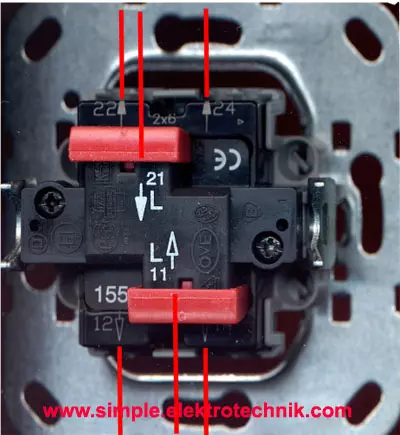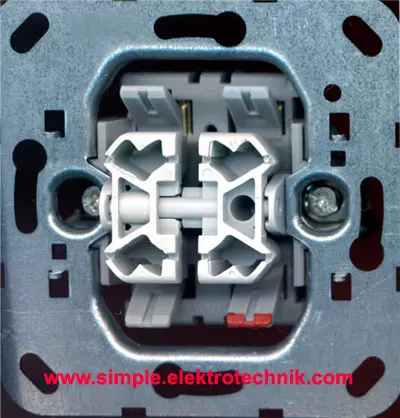Instructions for Installing and Connecting a Series Push Button Switch:
A series push button switch is a switch that combines 2 separate switches into a single unit. It is often used when there is no space available for two separate switches at existing locations.
The series push button switch is designed to temporarily close two separate electrical connections when pressed, and open them again when released. Unlike a toggle switch, the push button switch has only two states - an "ON" state when pressed and an "OFF" state when not pressed. A push button switch is commonly used to trigger an action, such as ringing a bell or opening an electric door.
A typical example of using a series push button switch is for controlling lighting, for example, using it to control a staircase automatic switch or a latching relay switch. When the push button is pressed, the lamp turns on, and when pressed again, the lamp turns off. Thus, the push button switch allows controlling the lamp from different locations.
Compared to a toggle switch, which has only two switching positions, the series push button switch is not limited to one or two positions, as it can be easily expanded.
Structure and Function of a Series Push Button Switch:
A series push button switch consists of two separate switches housed together. Each switch has an input terminal and an output terminal. The terminals of a series push button switch are typically labeled as follows:

- Left switch input terminal (L)
- Left switch output terminal (↓1)
- Right switch input terminal (L)
- Right switch output terminal (↓2)
The operation of a series push button switch is similar to that of a conventional push button switch. When either of the two switches is pressed, there is a temporary connection between the corresponding input terminal and the output terminal of the first or second switch. When the switches are released, the connections are interrupted.
Pressing push button 1 establishes a connection between input 1 and output 1,4. Releasing the button establishes a connection between input 1 and output 1,2. This allows using it either as a circuit breaker or a circuit closer.
Pressing push button 2 establishes a connection between input 2 and output 2,4. Releasing the button establishes a connection between input 2 and output 2,2. This allows using it either as a circuit breaker or a circuit closer.
These "two switches" are electrically isolated. However, if you want to switch only one circuit with both switches, you need to connect input 1 and input 2 using a small wire bridge. This will connect the two inputs together.
Proper Wiring of a Series Push Button Switch:
Properly wiring a series push button switch requires careful handling to ensure proper functionality. Here is an easy-to-understand guide for the correct wiring of a series push button switch:

- Remove the cover of the switch box where the series push button switch will be installed to access the wiring.
- Take note of the positions of the terminals on the series push button switch. A series push button switch usually consists of two separate switches in one housing. Each switch has an input terminal (L1 and L2) and an output terminal (↓1 and ↓2).
- Connect the left switch's input terminal (L) to the phase (hot) wire of the circuit.
- Connect the right switch's input terminal (L) to the desired phase (hot) wire of the circuit.
- Connect the left switch's output terminal (↓1) to the phase (hot) wire of the load to be controlled, such as a latching relay or a bell.
- Connect the right switch's output terminal (↓2) to the phase (hot) wire of the load to be controlled, such as a latching relay or a bell.
- Ensure all connections are tight and secure. Use appropriate wire connectors or screw connections.
Properly wiring a series push button switch requires caution and following an accurate wiring guide. By connecting the correct terminals according to the manufacturer's specifications and making the appropriate connection to the lamp or target device, you ensure the circuit operates flawlessly. If you are unsure or need assistance, it is advisable to consult a professional to avoid potential mistakes. Safety always comes first.
Backside of the Series Push Button Switch
Output 2,2 Output 2,4
Input 2

Input 1
Output 1,2 Output 1,4
Frontside of the Series Push Button Switch

Instructions for Installing and Connecting a Series Push Button Switch:

- Ensure that the power supply to the circuit where the series push button switch will be installed is turned off. Switch off the corresponding circuit breaker or remove the fuse to ensure a safe working environment.
- Take the series push button switch out of the packaging and check if it is complete and undamaged. Ensure that all components and connections are in perfect condition.
- Remove the cover of the switch box where the series push button switch will be installed to access the wiring.
- Identify the terminals on the series push button switch. A series push button switch consists of two separate switches housed together. Each switch has an input terminal (L1 and L2) and an output terminal (↓1 and ↓2).
- Check the manufacturer's circuit diagram to identify the correct connections. The input terminal is usually labeled as "L". Ensure that you select the correct terminals for the wiring.
- Connect the left switch's input terminal (L1) to the phase (hot) wire of the circuit. Ensure that the connection is tight and secure to provide a stable current flow.
- Connect the right switch's input terminal (L2) to the phase (hot) wire of the circuit. Ensure that the connection is tight and secure to provide a stable current flow.
- Connect the left switch's output terminal (↓1) to the phase (hot) wire of the load to be controlled, such as a latching relay or a bell. Ensure that all connections are secure and correct.
- Connect the right switch's output terminal (↓2) to the phase (hot) wire of the load to be controlled, such as a latching relay or a bell. Ensure that all connections are secure and correct.
- Carefully check if all connections are tight and secure. Use appropriate wire connectors or screw connections to ensure a reliable electrical connection.
- Reattach the cover of the switch box to protect the wiring and complete a proper installation.
- Turn on the power supply again by switching on the circuit breaker or inserting the fuse. Ensure that all connections are correct and secure before reactivating the power supply.
- Test the series push button switch to ensure that it functions properly. Press the buttons to turn the load on and off and verify the correct operation.
If you feel unsure or have no experience with electrical installations, we strongly recommend seeking the assistance of a qualified electrician to ensure a correct and safe installation. Safety always comes first, and professional support ensures a smooth and secure process.

Push button switches have diverse applications in electrical engineering.
Here are some examples:
They are often used when there is not enough space to install two separate push button switches.
- Lighting circuits. Push button switches allow lights to be turned on and off from different positions, making it convenient to control the lights from multiple locations in the room.
- Staircase lighting. With push button switches, the lighting in different floors or sections of a staircase can be controlled. You can turn the lights on and off from both the bottom and the top of the stairs.
- Corridor circuits. In long hallways or corridors, push button switches enable the lighting to be controlled from various positions. This enhances safety and saves energy as the lights are only turned on when needed.
- Multiple switch circuits. In large spaces such as conference rooms or event halls, push button switches are used to control the lights from different switch positions. This ensures ease of operation and flexibility.
- Outdoor lighting. Push button switches are also used to control outdoor lighting, such as on terraces or in garden areas. By using push button switches, you can turn the outdoor lighting on or off as needed.
Series push button switches offer high flexibility and adaptability for controlling electrical circuits in various applications. It is important to proceed carefully during the installation and wiring of a series push button switch, and to follow the manufacturer's instructions to ensure proper functionality.
If you feel uncertain or have no experience with electrical installations, we strongly recommend seeking the assistance of a qualified electrician to ensure a correct and safe installation. Safety always comes first, and professional support ensures a smooth and secure process.
Elektrosicherheit: Richtlinien und Vorsichtsmaßnahmen für einfache elektrotechnische Arbeiten
Die Sicherheit hat oberste Priorität.

- Alle hier bereitgestellten Anleitungen und Informationen dienen rein informativen Zwecken und sollen ausschließlich zur Informationsbeschaffung und Weiterbildung verwendet werden. Sie sollten nicht als Ersatz für professionelle Beratung angesehen werden. Bei Zweifeln empfiehlt es sich, einen qualifizierten Elektriker hinzuzuziehen, um fachkundige Unterstützung zu erhalten.
- Es ist wichtig, die örtlichen Vorschriften und Bestimmungen bei elektrischen Arbeiten zu beachten. Arbeiten mit Strom sollten nur von qualifizierten Fachleuten durchgeführt werden, da sie lebensgefährlich sein können.
- Fehler in Anleitungen und Schaltbildern sind möglich. Der Anbieter übernimmt keine Gewähr oder Haftung für Schäden oder Verletzungen, die aus der Umsetzung der bereitgestellten Informationen resultieren könnten. Es liegt in Ihrer Verantwortung, die Richtigkeit der Informationen zu überprüfen und die erforderlichen Sicherheitsvorkehrungen zu treffen.
- Die Verwendung geeigneter persönlicher Schutzausrüstung (PSA) ist entscheidend, um die Sicherheit bei elektrotechnischen Arbeiten zu gewährleisten. PSA schützt vor Stromschlägen, Augenverletzungen, thermischen und mechanischen Gefahren. Es ist jedoch wichtig zu beachten, dass PSA allein nicht ausreicht und durch Fachwissen, Fähigkeiten und die Einhaltung von Sicherheitsvorschriften ergänzt werden muss.
- Arbeiten an Teilen, die unter Spannung stehen, sind strengstens untersagt. Vor Beginn der Arbeiten müssen geeignete Sicherheitsvorkehrungen getroffen werden, einschließlich des Freischaltens der Anlage.
- Bei Schäden durch mangelhafte Elektroinstallation haftet der Errichter der Anlage gemäß den geltenden gesetzlichen Bestimmungen.
- Diese Zusammenfassung von Richtlinien und Vorsichtsmaßnahmen ist nicht umfassend. Bei Unsicherheiten ist es ratsam, einen qualifizierten Elektriker zu konsultieren oder sich an örtliche Vorschriften und Bestimmungen zu halten, um maximale Sicherheit zu gewährleisten.
- Die ordnungsgemäße Installation und Wartung von elektrischen Anlagen und Geräten ist von großer Bedeutung, um mögliche Gefahren zu minimieren und ein sicheres Umfeld zu schaffen.